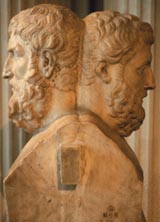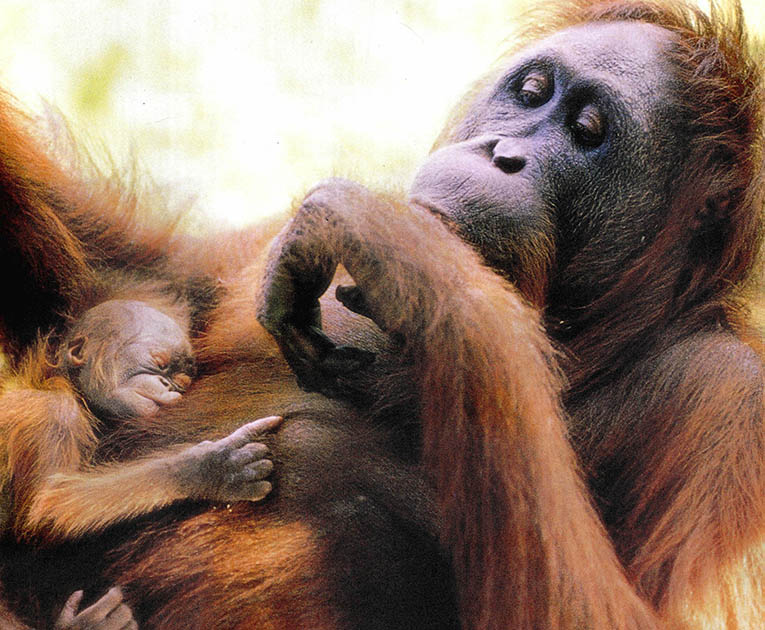독일의 과학자인 토마스 고르, 트라우테 클라인슈미트 그리고 한스 프리케 등 세명은 마치 실러캔스가 네발동물의 직계조상인듯한 혈족관계를 발표하였다.
네발동물이란 양서류 파충류 조류 포유류 그리고 우리 인간을 포함한다.
실러캔스란 공룡시대 이전에 생존하던 물고기로서 오래전에 멸종된 것으로 생각되었다. 한데 지난 1938년 남아프리카의 해안에서 트롤망으로 조업을 하던 한 어부의 그물에 이상한 물고기가 걸렸다. 그 어부는 이를 남아프리카 어류학자인 스미스씨에게 보여주었고 그는 그 물고기를 실러캔스라고 판정하였다.
이후 실러캔스는 (아프리카 대륙 남쪽) 코모로 공화국 주변에 서식하고 있음이 밝혀졌으며 지금도 어부들은 가끔씩 이 물고기를 낚곤 한다. 실러캔스는 해저 6백피트지대에 사는데 지금까지 1백70마리가 육지로 잡혀왔다. 그러나 불행하게도 실러캔스는 수압이 없이는 버티지 못해 잡힌후 수시간밖에 살지 못한다.
따라서 한스 프리케씨는 지난 1986년에 특별히 설계된 2인용 잠수함을 이용하여 실러캔스의 고향까지 깊이 잠수해 들어가 실러캔스가 뒤로도 거꾸로도 헤엄치는 등 모든 방향으로 헤엄칠 수 있음을 알아냈다.
프리케씨와 그의 두 동료는 지난 1991년 5월에 연구논문을 발표하였는데 이 논문에서 그들은 실러캔스의 피에 포함된 아미노산의 고리는 올챙이의 아미노산에서 볼 수 있는 고리형태와 매우 유사함을 보여주었다.
네발동물중에서 양서동물은 가장 덜 진화되었으며 양서류중에서도 올챙이는 가장 덜 진화된 것이다. 올챙이는 알에서 꼬리와 아가미를 갖추고 다리는 없는채 아주 작은 물고기 형태로 깨어나온다. 올챙이가 점점 커가면서 꼬리가 없어지고 아가미는 허파로 바뀌며 다리가 생긴다.
결과적으로 만일 올챙이의 아미노산 고리가 실러캔스의 것과 닮았다면 우리는 실러캔스가 올챙이와 무슨 관련이 있으리라는 것을 추정해 볼 수 있다. 실러캔스는 어쩌면 올챙이의 조상이며 사람을 포함한 다른 네발 동물의 조상일는지 모른다. 뿐만 아니라 실러캔스와 올챙이와의 관계는 올챙이와 네발동물의 그 어떠한 조상과의 관계보다도 더욱 가깝다.
그 아미노산 고리형태는 개구리에 이르면 나타나지 않으므로 우리는 단지 네발동물의 가장 원시형태인 올챙이가 실러캔스의 후손이라고만 가정해 볼 수 있다.'
또 하나의 중요한 지적사항으로, 실러캔스는 6개의 지느러미를 가졌는데 이중 넷은 두개의 쌍으로 이루어져 있다는 것이다. 프리케씨가 해저에서 실러캔스를 관찰하였을 때 그는 그 네 지느러미가 물고기가 아닌 네발동물의 다리처럼 움직임을 밝혀냈다.
그러나 이러한 사실이 대부분 그렇듯이 실러캔스와 올챙이와의 관계를 모든 생물학자들이 받아들이고 있지는 않다. 아미노산 고리는 다르게도 해석될 수 있으며 두종의 관계를 증명하지는 못한다는 것이다.
사실 폐어(肺魚)라는 또 다른 종류의 물고기도 오래전 멸종되었다고 믿어졌으나 19세기에 이르러 다시 발견되었다. 6마리도 못되는 폐어가 현재 생존해 있는 것으로 알려지고 있다.
폐어는 원시적인 허파를 가지고서 필요에 따라 공기를 들이켠다. 이들은 소금기 있는 물에서 나와 큰 못(池)으로 나아갈 수도 있다.
특히 여름철처럼 못으로 옮길 수 없을 때면 폐어는 진흙속에서 자신을 과자처럼 굳게하여 하계절동안 별 움직임 없이 보낸다. 이를 '여름나기'라고 부르며 이는 다른 동물의 '여름잠'과 같은 성격의 것이다.
어떤 폐어들은 만일 가끔씩이라도 공기를 들이켤 수 있는 위치에 있지 못하면 물속에서 익사하는 경우까지 발생한다.
여러 생물학자들은 폐어가 네발동물의 조상이라고 믿고 있으며 허파의 존재가 실러캔스의 지느러미나 아미노산 고리보다 더욱 중요하다고 생각한다. 아마도 이같은 논란은 오래도록 해결되지 못할 것이다.
나 자신은 실러캔스편에 더 큰 가치를 두고 있다. 나는 아미노산 고리에는 공감하고 있지만 원시적 허파에는 감동받지 못했다.
따라서 나는 공룡시대 이전에 살았을 뿐 아니라 네발동물이 일반적으로 살았던 시대 이전에(공룡은 진화된 네발동물이다) 살았던 실러캔스를 우리의 조상으로 바라볼 수 있음을 믿는다.
실러캔스가 네발동물의 조상으로서 그 후손들이 엄청난 유형으로 발전해 왔음에도 불구하고 그 자신은 원형을 유지한 채 전혀 변하지도 진화하지도 않았음은 정말 기가 막힐 사실이다. 실러캔스가 무려 4억년간의 나이를 가지는 그 기나긴 세월동안 거의 변하지 않았으니 말이다. 물밖의 환경을 견디지 못한다는것이 안타까울 뿐이다. 견딜 수만 있다면 우리는 훨씬 가깝게 관찰해 볼 수 있을텐데.
Our Ancestor, The Coelacanth?
Three German scientists—Tomas Gorr, Traute Kleinschmidt and Hans Fricke — are reporting a kinship that makes it appear as tetrapods are "four-footed animals" that include amphibians, reptiles, birds and mammals — us.
The coelacanth is a fish known to exist in the days before the dinosaurs but was thought to be long since extinct. Then, in 1938, a fisherman trawling off the coast of South Africa caught a strange creature in his net. He eventually showed it to a South African ichthyologist, J. L. B. smith, who identified it as a coelacanth.
Since then, it has been found that coelacanths live in the Comoros and that fisherman bring up one now and then. The coelacanths live at depths of about 600 feet and altogether 170 specimens have been brought to the surface. Unfortunately, they cannot withstand the loss of water pressure and only live a few hours when surfaced.
Finally, Hans Fricke, making use of a specially designed two-man submarine in 1986, managed to get down low enough to follow the coelacanth in its home waters and found that the coelacanth could swim in every direction, including backwards and upside down.
Fricke and his two colleagues published a paper in May, 1991, in which they showed that blood taken from coelacanths possessed chains of amino acids that strongly resembled similar chains of amino acids in tadpoles.
Of all the tetrapods, the amphibians are the least advanced and, among the amphibians, the tadpoles are the least advanced. They hatch out of eggs in tiny fish form, with tails and gills and without legs. It is only as they develop that the tails disappear, the gills turn to lungs and legs form.
Consequently, if tadpoles resemble coelacanths in their amino acid chains, we can only suppose that the coelacanths have some sort of association with tadpoles. The coelacanths are probably the ancestors of tadpoles and of all the other tetrapods, including man, What's more, the relationship between coelacanths and tadpoles is closer than that of tadpoles with any other creature that might possibly have been a tetrapod ancestor.
The amino acid chain doesn't show up in the adult frog, so we can only assume that the tadpole, the most primitive tetrapod of all, is the descendant of the coelacanth.
Another important point is that the coelacanth has six fins, four of which move in pairs. When Fricke studied the coelacanth under water, he found that these four fins moved in a way common to four-legged animals but to fish.
However, as usual in these cases, the connection between coelacanths and tetrapods is by no means accepted by all biologists. The complaint is that amino-acid chains can be interpreted in different ways and are by no means proof of a connection.
In fact, there is another kind of fish, the lungfish, also long thought to have been extinct but rediscovered in the 19th century. No less than six living species of lungfish are now known.
Lungfish have primitive lungs and can, and do, gulp air when necessary. They can manage to get out of brackish water and make their way to larger pools.
When this is not possible, especially in the summer, they can cake themselves in mud and stay largely immobile for the season. This is called "estivation," Which is parallel to hibernation among other animals.
Some lungfish are even likely to drown if they cannot be in a position to gulp air now and then.
A number of biologists believe that lungfish are the ancestors of the tetrapods, and that the presence of lungs is more important than the presence of coelacanth fins or of amino-acid chains. The chances are that the argument will not settle down for a long time.
I am on the side of the coelacanth, for what that's worth. I'm impressed by the amino-acid chain, and I'm not impressed by the primitive lung.
Consequetly, I believe that the coelacanth, which existed not only before the time of the dinosaurs but before the time of the tetrapods generally(the dinosaurs were advanced tetrapods), could be looked upon as our ancestor.
It's really amazing that the Coelacanth, having served as the ancestor of the tetrapods and having had descendants who developed in enormous ways, should nevertheless maintain itself in a form that did not change and did not develop. It is 400 million years old and has scarcely changed in all that time. What a pity it cannot withstand surface conditions. We could study it so much better if it could.
(C)1991. Los Angels Times syndicate
이 기사의 내용이 궁금하신가요?
기사 전문을 보시려면500(500원)이 필요합니다.
1991년 08월 과학동아 정보
🎓️ 진로 추천
- 생명과학·생명공학
- 해양학
- 지구과학

















